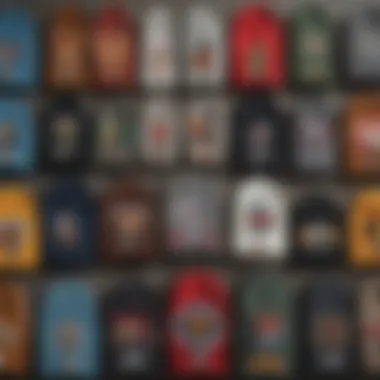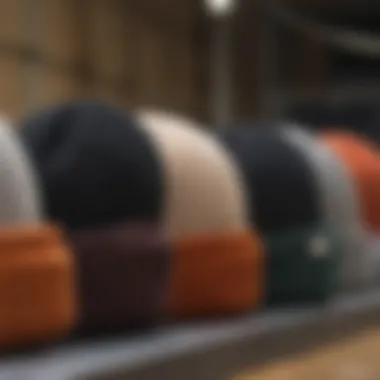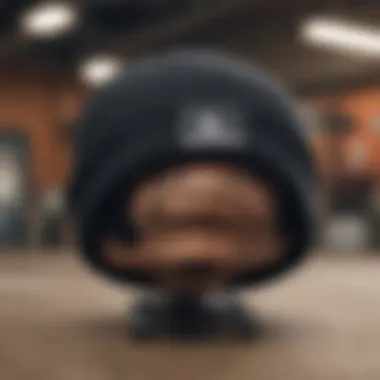Exploring Top Beanie Styles in Skate Culture


Intro
Beanies have woven themselves into the fabric of skate culture, but their story runs deeper than mere aesthetics. Originally a functional accessory to fend off the cold, they’ve now carved a niche style, merging both utility and flair. From the ramps of California to the streets of Tokyo, the beanie signifies more than warmth; it embodies an attitude and a lifestyle.
As skaters can attest, a good beanie not only keeps you cozy during those chilly morning sessions but also offers a canvas for self-expression. The diverse materials, designs, and branding that have emerged capture the ever-evolving spirit of skateboarding. This article seeks to unearth the nuances of how this humble headwear has adapted, from its origins to its current status as a must-have accessory.
Techniques and Skills
Essential Tricks for Beginners
For those just starting their journey on the board, mastering the fundamentals is crucial. Learning to balance, push, and stop effectively lays the groundwork for more advanced maneuvers. Here are a few essential skills:
- Pushing
- Stopping
- Turning
- Start by finding your balance on the skateboard. Keep one foot on the board and use the other to push off the ground.
- The foot brake is a useful technique where you drag your back foot on the ground to bring the board to a halt.
- Lean into your turns while shifting your weight, allowing the board to pivot underneath you.
These basic tricks might seem straightforward, but they require practice. They are the bedrock upon which more complex skills are built.
Advanced Techniques for Pros
Once the fundamentals are second nature, aspiring skaters can tackle advanced skills that showcase their sophistication and style. These might include:
- Ollie
- Grinds and Slides
- Kickflips and Heelflips
- A fundamental jumping move that allows the skater to elevate off the ground while keeping the board beneath their feet.
- Utilizing edges of rails or ledges, these tricks add flair to any skater's technique, requiring precise balance and timing.
- These tricks involve rotating the board while in the air, effectively popping the board with one foot while using the other foot to flip it.
A key part about mastering these advanced skills lies in understanding the importance of practice. Consistency in each trick leads to building muscle memory, which is essential for progression.
"Skating is not just about performing tricks but more about expressing who you are while flying down the pavement."
Skateboarding Culture
The Evolution of Skateboarding
Starting in the 1950s, skateboarding burgeoned from a creative outlet for surfers onto a defined sport and lifestyle. Initially, boards were simply wooden planks with wheels attached. Today, technology and a wider variety of materials have transformed the skateboard into a complex piece of equipment. The beanie found its way alongside skateboarding, becoming a staple as skaters began to engage in the sport year-round.
Influential Skateboarders and Their Impact
Numerous skaters have left profound marks on the sport and culture, from pioneering techniques to becoming fashion icons. Tony Hawk, for example, not only pushed the limits of what skaters could do but also popularized skate culture through various media.
Similarly, Nyjah Huston has redefined competitive skating with his technically ambitious tricks and social media presence. Both have contributed to making beanies more than mere accessories; they've become a symbol of the lifestyle, often adorned with logos and artwork that reflect personal and brand identities.
The beanie is no longer just wear; it’s a statement. Whether it's a classic roll-up style or a contemporary variation, it offers insight into one's personality and connection to skate culture.
Foreword to Beanies
Beanies might seem like a simple accessory, yet they hold a wealth of significance in numerous subcultures, thrumming with history and vibrant personality. Within the realm of skateboarding, these snug caps are not just about warmth; they encapsulate a sense of identity, rebellion, and community. Exploring the intricacies of beanies within skate culture allows us to understand not only the evolution of style but also the dialogues and narratives that accompany them.
A beanie is a canvas that reflects personal style and perspective. For skaters, it can symbolize belonging to a community or walking the path of a particular lifestyle. The choice of color, pattern, and fit can even serve as a badge of allegiance to specific skate brands that resonate with their values or aesthetic. In a world where visual expression plays a pivotal role, beanies emerge as an essential part of the ensemble, often chosen to complement a skateboarder's distinctive character.
Historical Context
The origins of the beanie can be traced back to various cultures. Historically, beanies were practical garments worn to keep the head warm during colder months. In the mid-20th century, their popularity began to skyrocket, particularly as they became associated with the countercultures of the time.
As skateboard culture began to blossom in the 1970s, the beanie gracefully made its entrance onto skateboards and backlots. Early skate pioneers often sported these knitted caps, initially for warmth during those chilly California mornings. As styles evolved, so did the use of the beanie, transitioning from a piece of gear to a statement accessory that could amplify one’s skate persona.
Furthermore, the adoption of beanies by surf and punk communities paved the way for their integration into skate culture. The beanie was a symbol of resistance, a subtle nod to those who chose to express themselves outside conventional fashion norms. In those days, whether one donned a brightly colored beanie or a muted knit, it was all about attitude.
Cultural Significance in Skateboarding
When one sets foot on a skateboard, selecting a beanie isn't merely about shielding one's head; it's a choice steeped in layers of meaning. The beanie occupies a unique space in the skateboarding world, acting as a bridge between functionality and style.
Many prominent skaters have made their mark not just through tricks and flips but through signature styles that often factor in their choice of headwear. The beanie provides a sense of solidarity among skaters, creating a visual language that transcends verbal communication. It's the unifying element at parks, competitions, and exhibitions alike.
"It's more than a mere beanie; it’s a thread in the fabric of skate: comfort, culture, and camaraderie rolled into one."


Moreover, as skateboarding has gained massive mainstream traction, beanies have evolved into a badge of authenticity. In a landscape saturated with commercialism, wearing a beanie still connects skaters to their roots, to the grassroots movements that championed the sport. Each time an individual ties on their beanie, they're participating in an unbroken chain of expression, rebellion, and individualism that continues to flourish today.
In sum, understanding the beanie's role in skate culture isn't just an exploration of an accessory; it's a dive into a rich, cross-generational dialogue that speaks of rebellion, identity, and community.
The Evolution of Beanie Styles
The saga of beanies in skate culture is more than merely a tale of covering heads; it embodies a narrative of transformation, functionality, and style intermingled with the grit and unpredictability of skateboarding. As the sport has matured, so has the aesthetic around it. From a simple warmth-providing cap to an emblem of lifestyle, the evolution of beanie styles plays a pivotal role in shaping not just fashion but identity among skaters.
Traditional Beanie Designs
Traditional beanie designs can be traced back to humble roots. Initially, these headwear were born out of necessity, primarily crafted from wool or cotton to ward off cold winds. Their classic shape—streamlined, snug, and often cuffed—became synonymous with timelessness. In skateboarding circles, the design's practicality allowed skaters to maintain focus on their performance without distraction. The lack of frills and embellishment made them accessible yet resonant, providing a blank canvas for individuality.
- Material Choices: Common materials included wool for warmth and cotton for comfort, reflecting a balance between functionality and ease of wear.
- Color Palette: The traditional aesthetic leaned toward neutral tones, earthy colors that embraced the underground scene's vibe.
- Cultural Roots: Many early skaters adapted these beanies from other subcultures, infusing their unique spin while maintaining the core functionality.
Interestingly, during the late 1970s and early 80s, beanies began to integrate into skateboarding fashion displays, creating a bridge between function and personal expression. They resonated with the punk scene as much as with surf culture, which ultimately cemented their position in skateboarding history.
Modern Adaptations
In stark contrast to their forebears, modern adaptations of beanies have transcended their simple origins into a realm of diverse designs and functions. Today’s beanies are far more than functional pieces; they’ve become a statement, reflecting personal style and skater identity.
With an array of styles like slouchy, cuffed, and even hooded designs, the modern beanie is now synonymous with versatility. More than ever, there is a blend of form and function, understandable when you consider how skaters prioritize comfort while shredding.
- Diverse Styles: From snug fits to oversized silhouettes, options now cater to individual tastes and aesthetics.
- Graphic Influences: Nowadays, many brands collaborate with artists and designers, leading to unique prints and patterns that speak to the skater's personality.
- Sustainability: As awareness grows about environmental issues, many contemporary brands focus on sustainable materials, assuring that modern beanies not only look good but also align with ethical values.
"Beanies are not just accessories; they are a canvas for self-expression within skate culture."
Fabric and Design Elements
The world of beanies, especially in skate culture, cannot be fully appreciated without recognizing the fabric and design elements that contribute to their appeal. Understanding these facets is crucial because they directly influence comfort, durability, and the overall aesthetic value of the beanie. This section offers a closer look at the materials that define these essential accessories and the craftsmanship that elevates them in the eyes of skaters and fashion enthusiasts alike.
Materials That Matter
When it comes to beanie materials, what you choose can make or break your experience. The types of fabrics used play a significant role in comfort, warmth, and breathability. Here are some commonly used materials found in beanies:
- Acrylic: Known for its soft feel and ability to retain warmth, acrylic is an affordable option that mimics wool. Many skaters prefer acrylic for its lightweight quality and vivid color retention.
- Wool: This classic material is unbeatable when it comes to natural insulation. Wool has moisture-wicking properties, which helps keep sweat at bay during intense skating sessions. Merino wool, in particular, stands out for its softness and thermal regulation.
- Cotton: For those warmer days or for casual wear, cotton beanies provide a breathable and comfy experience. Their softness against the skin makes them a popular choice for everyday use.
In addition to the fabric, the blend of materials can offer unique benefits. For example, a cotton-acrylic blend often combines the best attributes of both fabrics, providing breathability along with warmth. Skaters are often seen opting for beanies that ensure they stay comfortable regardless of the weather conditions.
"The right fabric not only impacts how it feels but also how it performs on the board."
Craftsmanship and Quality
While materials are foundational, the craftsmanship of a beanie cannot be understated. Quality in beanie-making often distinguishes a mere accessory from a sought-after item amongst skaters. Here are some vital considerations:
- Knit Techniques: The methods employed in knitting the fabric significantly affect the drape and stretch of the beanie. Techniques like ribbing can offer a snug fit, which is favored when performing tricks.
- Stitching and Finish: Look for beanies with reinforced stitching to ensure longevity. Cheaply made beanies often unravel or lose shape after a few wears. Paying attention to the quality of the seams can save you from buying a replacement sooner than you’d like.
- Fit and Design: Beyond just looking good, a well-crafted beanie fits snugly without being overly tight. Designs that incorporate features like ear flaps or double layered fabrics enhance both protection and style, keeping a skater's head warm without sacrificing freedom of movement.
Achieving an ideal blend of style, functionality, and durability is the name of the game. Thus, when selecting a beanie, skaters ought to ensure it meets their requirements not only in aesthetics but also in craftsmanship.
In summary, as beanies continue to be a staple in skate culture, understanding the fabric and design elements paves the way for more informed choices. From selecting the right materials to appreciating the craftsmanship behind each piece, these considerations greatly influence how beanies are integrated into the skater lifestyle.
Functionality of Beanies
In the skate culture sphere, beanies serve a dual purpose—they’re not just a style statement but a practical accessory that can't be overlooked. Understanding their functionality sheds light on why they have maintained their place in the skateboarding community. Beanies offer various benefits beyond mere aesthetics, making them an essential part of a skater's kit.
Warmth and Protection
When the winds start to howl and temperatures drop, warmth becomes a key consideration for skaters. A quality beanie provides insulation, keeping the heat close to your head. This warm coverage is particularly vital for those long days spent riding through chillier months. The beanie can act as a barrier against the cold, reducing the risk of discomfort during a session that stretches through a late afternoon.
It's not just about warmth; protection is also a priority. Many skaters will tell you that they’ve first-hand experienced how a beanie can cushion a fall just a tad better, especially when one lands awkwardly. It can absorb some of the impact against the hard ground, making it a smart choice when testing out new tricks.
"A beanie isn't just something to wear, it’s a shield when the ride gets rough."
For skaters who often find themselves skating in unpredictable weather, a beanie made from water-resistant materials can keep your head dry—essential for maintaining focus while performing tricks.
Style Versatility
A beanie is about more than just keeping warm; it’s also a versatile accessory that can elevate any outfit. You’ll spot skaters rocking beanies in a wide array of styles, colors, and patterns, matching their personal flair or the character of their skateboard. A simple beanie can go with anything from a baggy sweatshirt to a more tailored jacket, making it an ideal piece for any skater.
The styles range widely, from classic cuffed varieties to slouchy fits that can be worn low, reflecting the individual personality of the skater. The adaptability also extends to combinations—some skaters layer a beanie over their hoodies or even with helmets while sticking to their own unique aesthetic.
In terms of color and design, the beanie can serve as a statement piece or a subtle complement, easily adjusting to current trends or personal preferences. This fluidity shows how a simple piece of clothing can experience iterations based on contemporary culture, making it more than just an accessory—it's part of one's identity.
In summary, beanies are filled with practical functionalities that resonate with skaters. They provide warmth and an element of protection while also being a canvas for personal expression. In the dynamic and expressive world of skate culture, each beanie tells a story of its wearer's experience and style.


Brand Influence on Beanie Trends
Beanies are not just headwear; they are a reflection of culture, identity, and the values of the skateboard community. In recent years, the influence of brands on beanie trends has been paramount. This section explores the undeniable impact that recognized brands and strategic collaborations have had on shaping fashion choices in the skateboarding world. As skaters choose beanies not only for warmth but also for a way to express individuality, brand influence becomes crucial in dictating what styles prevail.
Recognized Brands in Skate Culture
In the landscape of skateboarding, certain brands have forged their names into the fabric of skate culture itself. Take for instance Supreme, known for its limited drops and bold logos. Supreme beanies are an emblem of status; often, just wearing one signifies belonging to an elite circle. Other brands like Element and Thrasher encapsulate both functionality and style, highlighting how skaters prioritize not just how a beanie looks but also how it performs during intense skate sessions.
These brands don’t merely pump out merchandise; they cultivate a lifestyle around their products, reinforcing loyalty and community. The allure of wearing a well-recognized brand creates a subconscious theft of cultural capital, enabling skaters to feel connected to a larger narrative or community.
Thus, while practicality in beanies remains essential, the brand name often sways purchasing decisions. It's like an unspoken agreement among skaters: if you wear the right brand, you’re in the loop.
Influential Collaborations
Brand collaborations have taken the beanie game to a whole new level. For instance, collaborations between Nike SB and artists like Daan Van Der Linden have resulted in limited edition beanies that not only serve as clothing but as collectible art. When two respected entities from different realms join forces, the result can amplify both marketing effectiveness and creative vision. These partnerships often fuse distinctive aesthetics with top-notch quality, producing items that are sought after not just for their utility but as unique fashion statements.
Another collaboration that made waves was the partnership between Adidas and Palace Skateboards. This innovative mixing of streetwear with skate culture positioned beanies as versatile enough to wear beyond the skate park. These designs often include trendy patterns and vibrant colors that push the boundaries of traditional beanie aesthetics.
Collaborative efforts forcefully challenge the status quo, offering new perspectives on what beanies can represent.
Such collaborations are often marketed via social media platforms, drawing attention from influencers and skate legends alike, which naturally leads to increased visibility among youths looking for identity through fashion.
In summary, understanding the brands and collaborations driving beanie trends provides deeper insights into the skate culture. Skaters do not merely choose beanies; they select emblems of identity, belonging, and artistry that resonate with their lifestyle, allowing them to navigate the culture with a sense of pride and authenticity. As we move further along the article, it becomes essential to analyze the vibrant styles available in the market, each echoing these commercial influences.
Top Beanie Styles in the Market
When steppin' into the realm of skate culture, one can't ignore the distinctive role that beanie styles play. Beanies are not just about keeping one’s head warm; they’ve become a statement, a symbol of identity, lifestyle, and function. In this section, we unpack myriad top beanie styles currently claiming their stake in the market, focusing on what makes each style unique not only within skate circles but also in broader fashion landscapes.
"A well-chosen beanie is as essential as the board itself for those who skate with pride."
Classic Cuffed Beanies
Classic cuffed beanies are the OG of the beanie world, beloved by many skaters for their versatility and comforting fit. Typically made from acrylic or wool, these beanies sport a folded cuff that adds a bit of extra warmth around the ears. Whether you’re pounding the pavement or chilling at the skate park, this style adapts to various temperatures.
These beanies have a wide appeal, catering to a diverse demographic. From seasoned skaters who have embraced the lifestyle for years to newcomers trying to find their footing, the classic cuffed beanie melds easily with various outfits. They pair nicely with oversized jackets or even fitted hoodies. The aesthetic is simple yet impactful, proving that sometimes, less is indeed more.
Additionally, classic cuffed beanies often feature logos or subtle designs that help them stand out. Brands like Stussy and Obey have incorporated this style into their collections, making them staples in both skate shops and streetwear boutiques.
Slouch Beanies
Slouch beanies roll in with more of a relaxed vibe. With their longer body and the capability to hang loose, they have an effortless feel that resonates with many skaters. The slouch style offers a more laid-back approach, making them a favored choice for casual outings or lazy days.
Materials for slouch beanies are typically soft and stretchy, which also means they provide a comfortable fit. They're often available in bold colors or with funky patterns, allowing wearers to express their playful sides. Some of the most popular brands offering slouch beanies include Volcom and Hurley, known for their youth-centric styles.
When worn correctly, slouch beanies can also add an air of nonchalance to any outfit. Their ability to look good while seeming effortlessly thrown on is a skill only a few can master. Yet, the balance lies in knowing when it complements the rest of your ensemble.
Beekeeper and Balaclava Styles
Emerging as niche options within skate fashion, beekeeper and balaclava styles have begun to draw attention for their distinctive features. The beekeeper style, characterized by its loose, draped fit, not only looks cool but also offers ample warmth. These styles often extend down the neck, making them perfect for skaters who don’t shy away from colder weather.
On the other hand, the balaclava beanie provides comprehensive coverage, with openings only for the eyes. While this might not be the typical choice for all skaters, it introduces an avant-garde flair to outfits, appealing to those looking to push their limits when it comes to style. They're often printed with eye-catching designs or incorporated into skate brand collaborations, which helps them gain traction among the more fashion-forward skaters.
Both styles speak to the evolving landscape of skate culture, where expressiveness is often equated with individuality. For those who embrace this unique aesthetic, beekeeper and balaclava styles provide new opportunities to stand out, merging functionality with flare.
The evolution of beanie styles continues to mirror the dynamic nature of skate culture, influencing attitudes, and setting trends that keep it fresh.
Color Trends in Beanies
Beanies aren’t just about keeping warm or showcasing your skate style; they're also a vibrant canvas for personal expression. In the landscape of skate culture, color trends in beanies hold a pivotal role. These hues make a statement, shattering the monotony that sometimes overshadows winter accessories.
When skaters choose their beanies, they often seek colors that reflect their personality or mood. A bright, eye-catching orange may signal a bold and fearless attitude, while muted grey could hint at a more laid-back, effortless style. This diversity in color choices allows each skater to convey aspects of their identity without saying a word. Furthermore, color trends can merge with seasons, seen vividly in collections that speak to the spirit of each time of year.
The implications of color also extend into branding and product differentiation within the market. As companies strive to carve out their niche, utilizing distinct color palettes becomes essential. This helps them stand out amongst the sea of competitors while catering to the evolving tastes of skaters.
Seasonal Color Palettes
In skate culture, the seasonal color palette can shift like the weather. Spring and summer often bring out brighter shades and pastels, igniting that playful, vibrant vibe as skaters enjoy longer days under the sun. Think light blues or lively yellows that resemble cheerful blooms instead of the dreary tones of winter toil. Conversely, when the leaves turn and winter chills kick in, darker hues such as navy, burgundy, and forest green become the fast favorites. It's a reflection of not just the weather, but also the collective mood of the skating community in those times.
Examples of Seasonal Colors
- Spring/Summer: Soft pinks, bright teal, sunbeam yellow
- Fall/Winter: Deep plum, charcoal grey, rustic orange
These seasonal shifts breathe new life into beanie selections, rekindling enthusiasm among skaters who want their wardrobe to harmonize with the time of year.


Graphic Patterns and Unique Prints
Sometimes, it’s not enough to simply go for a solid color- that’s where graphic patterns and unique prints come into play. These designs allow skaters to showcase their creativity and passion for art, not just skateboarding. Popular motifs can range from bold geometric shapes to intricate, hand-drawn representations of skate culture itself, including skateboards, graffiti, or vivid street art.
Graphic beanies can transform into conversation starters, signaling shared interests and fostering camaraderie among skaters. They can act as a badge of honor, showcasing allegiance to a particular skate brand or artist, thus deepening the communal bonds within the culture.
Moreover, brands often use exclusive graphic designs to launch limited edition beanies, creating a buzz among collectors. Such strategic moves not only drive sales but also perpetuate the cycle of brand loyalty and cultural significance in skateboarding.
"A beanie is not just an accessory, it's a statement of who you are and what you ride for."
Beanies in Media and Popular Culture
Beanies have not only found their way into the wardrobes of skateboarders but have also become emblematic in media and popular culture. Their presence extends far beyond the skate parks, making appearances in films, television series, and even music videos. This widespread visibility helps in cementing their status as a cultural icon, particularly within the realm of youth and alternative subcultures.
Iconic Skateboarding Films
The influence of beanies in skateboarding films cannot be overstated. Movies like Dogtown and Z-Boys provide a glimpse into the lives of the pioneers of skate culture. In these films, beanies often serve as more than just headgear; they represent a certain attitude and lifestyle that resonates with skaters worldwide. A classic example can also be found in Lords of Dogtown, where the characters rock their beanies with a style that speaks to their rebellious spirit.
Beanies in these films often reflect the distinct character traits of skaters. For instance, a character wearing a slouch beanie may be depicted as laid-back and carefree, while someone in a fitted beanie might exude a more intense approach to skating. The connection between a character's personal style and their headgear sets a tone that resonates with audiences, making beanies essential props in storytelling.
"Beanies have become essential to skateboarding culture; they don't just keep your head warm, they complete the look."
Influential Skateboarders and Their Styles
The beanie's integration into skate culture is intimately tied to the influential skaters who endorse them. Skaters like Tony Hawk and Nyjah Huston have been spotted donning various styles of beanies throughout their careers, setting trends that inspire countless fans. For many hobbyists, emulating their fashion choices is often as important as emulating their skating techniques.
The styles they choose often reveal their personal philosophies about skateboarding. For example, Nyjah Huston is known for his sharp, modern flair, preferring fitted beanies that align with a clean, urban aesthetic. In contrast, older skaters may gravitate towards more traditional beanie styles that harken back to the roots of the sport.
Notably, the beanie acts as a blank canvas for individual expression. Popular skate influencers utilize their social media platforms to showcase their unique approaches to wearing these caps, whether incorporating bold colors or intricate patterns. This trend paves the way for a new generation of skaters to adopt the look while infusing their interpretations into what it means to wear a beanie.
In summary, the presence of beanies in media and popular culture serves to reinforce their importance in skate culture. Through iconic films and the influence of notable skaters, beanies have been woven into the very fabric of this dynamic community.
The Future of Beanies in Skateboarding
Beanies have long been a staple in skateboard culture, but their future is particularly intriguing. Skaters are looking for functionality and style as they carve through parks and streets. This section explores the key aspects shaping the trajectory of beanies in this vibrant subculture.
Sustainable Practices and Innovations
With growing awareness about environmental impact, sustainability is making waves in the world of fashion, including skate gear like beanies. Brands are beginning to employ materials that are not only functional but also eco-friendly. The trend leans heavily towards using organic cotton, recycled polyester, and even innovative fabrics crafted from ocean waste.
- Why it Matters: The skateboard community often champions authenticity and loyalty to the environment, making sustainability a compelling storyline.
- Benefits of Sustainable Beanies:
- Made from materials that reduce waste and pollution.
- Support for companies that prioritize eco-friendly initiatives.
- Long-lasting quality, often surpassing that of conventional products.
A few brands are already stepping up their game. For example, Patagonia has made a name in the skate scene with their use of recycled materials, while Element has introduced organic cotton options. Together, these efforts show that skaters are increasingly considering both the earth and style when selecting their accessories.
Emerging Trends and Preferences
As we look ahead, several trends appear on the horizon for beanies in skateboarding. Skaters are not just interested in looking cool but also want their beanies to provide useful features. Trends unfolding include:
- Tech-Infused Fabrics: Imagine a beanie that regulates temperature or even repels water. Some brands are working hard to blend technology with tradition, resulting in gear that's both stylish and practical.
- Customization: More skaters are seeking the ability to express themselves through their clothing, including beanies. Custom designs, vibrant colors, and unique patterns have gained traction. This not only enhances individuality but also cultivates a more personal connection to the accessories.
- Cultural Influences: The influence of skateboarding goes far beyond the skatepark. Street art, music, and other cultural expressions are informing beanie trends, with graphics and logos becoming canvases for artistic expression.
"The future of beanies in skateboarding is as much about self-expression as it is about protection from the elements. It’s evolving and adapting just like the culture itself."
In summary, the future of beanies in skateboarding holds promise. Sustainability is reshaping how they're produced, while innovations and cultural influences redefine their aesthetic and functional appeal. As skateboarders continue to navigate their environment, the beanie will likely remain an indispensable part of their gear, reflecting both their passionate spirit and commitment to the planet.
Culmination: The Enduring Appeal of Beanies
Beanies hold an enduring significance in skate culture, evolving far beyond their original utilitarian purpose. They symbolize a true fusion of style, functionality, and community spirit, which resonates with skaters of all ages. As this article explored, the journey of beanies within the skateboarding world is rich and layered, revealing insights into their role as essential fashion statements and protective gear.
The evolution of beanies mirrors the shifts in skate culture itself. From simple, classic designs to bold, creative expressions, every style tells a story. Beanies serve not merely as accessories; they are a form of identity for many skaters. The significance of wearing a beanie transcends trends—it’s about belonging to a culture that values uniqueness.
In a practical sense, the functionality of beanies cannot be overlooked. They cater to various needs—be it keeping skaters warm during the chilly months or offering a stylish cover for a bad hair day after an exhilarating session. This duality enhances their appeal, making them a perennial favorite among skaters.
"Beanies are more than just fashion. They tell our stories, they protect us, and they connect us to one another."
Furthermore, as sustainability becomes a crucial concern across industries, beanies are embracing eco-friendly materials and practices. This shift not only caters to the growing demand for responsible consumption but also ties back into the community-based ethos that is so prevalent in skate culture.
Understanding the enduring appeal of beanies necessitates an appreciation for their journey. They remain a staple in the skateboarding community, evolving with each new generation of skaters while continuing to embody the spirit of rebellion, creativity, and camaraderie that defines skate culture.
Summary of Key Points
- Cultural Significance: Beanies are more than just headwear; they reflect the identity and values of skaters.
- Functional Role: They provide warmth and style versatility, making them practical for varied environments.
- Design Evolution: The styles have transitioned from traditional to modern, embodying changes in skate culture.
- Sustainability: A growing emphasis on eco-friendly materials highlights the cultural responsibility within skateboarding.
Final Thoughts on the Role of Beanies in Skate Culture
In closing, beanies encapsulate this dynamic scene—layering warmth with creativity and community. Each beanie worn is a badge, a nod to the personal history and memories tied to skate culture. They’re not just a trend to be followed; they represent a lifestyle, one that is informed by passion, resilience, and belonging. For skaters, choosing the right beanie is as significant as perfecting their trick; it’s woven into the very fabric of who they are and how they chose to express themselves.
Ultimately, as skate culture continues to grow and evolve, the beanie will undoubtedly adapt. Whether through innovative fabrics, unique designs, or new collaborations, one truth remains clear: beanies will forever be a significant aspect of skateboarding, bridging the gap between form and function in ways that resonate with all who ride.







